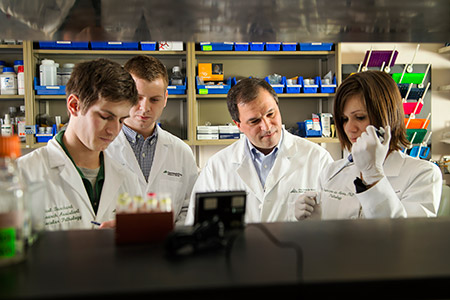Dartmouth Scientists Identify Genetic Blueprint for Rare, Aggressive Cancerous Tumors of the Appendix

Gregory Tsongalis, PhD
Their study, “Molecular Profiling of Appendiceal Epithelial Tumors Using Massively Parallel Sequencing to Identify Somatic Mutations,” was published in the journal Clinical Chemistry today. When specific mutations for a cancer type are identified, patients can be treated with chemotherapy or other targeted agents that work on those mutations.
Little is known about the molecular biology of two types of appendix tumors, low-grade appendiceal mucinous neoplasm (LAMN) and adenocarcinoma, but both can lead to pseudomyxoma peritonea (PMP), a critical condition in which cancerous cells grow uncontrollably along the wall of the abdomen and can crush digestive organs.
Dartmouth pathologists studied 38 specimens of LAMN and adenocarcinoma tumors (some of which had progressed to PMP) from their archives to look for shared genetic errors that might be responsible for the abnormal cell growth. Tissue samples were sequenced using the AmpiSeq Hotspot Cancer Panel v2, which pathologists had verified for the clinical screening of mutations in 50 common cancer-related genes for which treatments exist. This was the first study making use of a multigene panel in appendiceal cancers to support the use of potential targeted therapies.
“We routinely use this molecular profiling approach on all of our lung adenocarcinomas, melanomas, colon cancers, and gliomas,” said Gregory Tsongalis, PhD, principal investigator for the study and director of Molecular Pathology at Dartmouth-Hitchcock Norris Cotton Cancer Center. He says examining an individual tumor profile has the potential to significantly alter patient outcome in a positive way.
KRAS and GNAS mutations were the most common alterations identified in the study. Twelve distinct abnormalities were mapped to the KRAS gene. Additional mutations were identified (i.e., AKT1, APC, JAK3, MET, PIK3CA, RB1, and STK11 for LAMN and TP53, GNAS, and RB1 for adenocarcinoma) in the four sample types studied. Seven of these mutations were shared by more than one group, which suggests there is some molecular similarity.
“These findings suggest that tumors of the appendix, although rare and very aggressive, are distinct entities and have subclasses of disease within each category that are different from each other based on their mutation profile,” said Tsongalis. “New therapeutic approaches may be able to target those pathways that are mutated in these tumor types.”
This laboratory research has the potential to change clinical practice if physicians now develop treatment plans to target the identified genetic mutations. “Our success in the Dartmouth-Hitchcock Medical Center Department of Pathology at the Norris Cotton Cancer Center is attributed to our multidisciplinary approach to these discoveries, which truly allow us to bring scientific findings from the bench to the bedside,” said Tsongalis.
Norris Cotton Cancer Center combines advanced cancer research at Dartmouth and the Geisel School of Medicine with patient-centered cancer care provided at Dartmouth-Hitchcock Medical Center, at Dartmouth-Hitchcock regional locations in Manchester, Nashua, and Keene, NH, and St. Johnsbury, VT, and at 12 partner hospitals throughout New Hampshire and Vermont. It is one of 41 centers nationwide to earn the National Cancer Institute's “Comprehensive Cancer Center” designation. Learn more about Norris Cotton Cancer Center research, programs, and clinical trials online at cancer.dartmouth.edu.
For more information contact Robin Dutcher at (603) 653-9056.
Media Contact
More Information:
http://cancer.dartmouth.edu/about_us/newsdetail/70876/All latest news from the category: Life Sciences and Chemistry
Articles and reports from the Life Sciences and chemistry area deal with applied and basic research into modern biology, chemistry and human medicine.
Valuable information can be found on a range of life sciences fields including bacteriology, biochemistry, bionics, bioinformatics, biophysics, biotechnology, genetics, geobotany, human biology, marine biology, microbiology, molecular biology, cellular biology, zoology, bioinorganic chemistry, microchemistry and environmental chemistry.
Newest articles

Properties of new materials for microchips
… can now be measured well. Reseachers of Delft University of Technology demonstrated measuring performance properties of ultrathin silicon membranes. Making ever smaller and more powerful chips requires new ultrathin…

Floating solar’s potential
… to support sustainable development by addressing climate, water, and energy goals holistically. A new study published this week in Nature Energy raises the potential for floating solar photovoltaics (FPV)…

Skyrmions move at record speeds
… a step towards the computing of the future. An international research team led by scientists from the CNRS1 has discovered that the magnetic nanobubbles2 known as skyrmions can be…





















